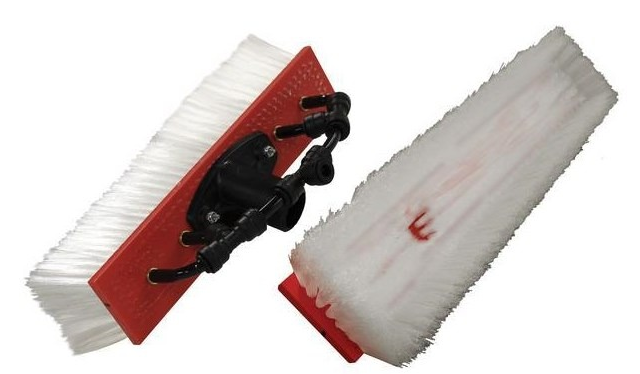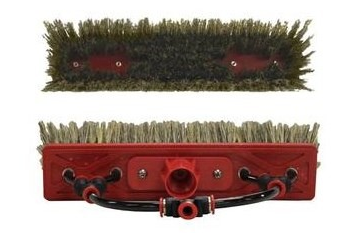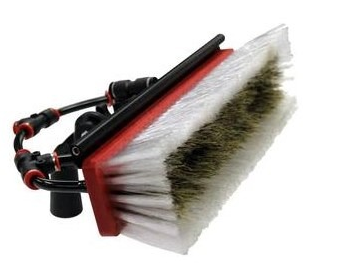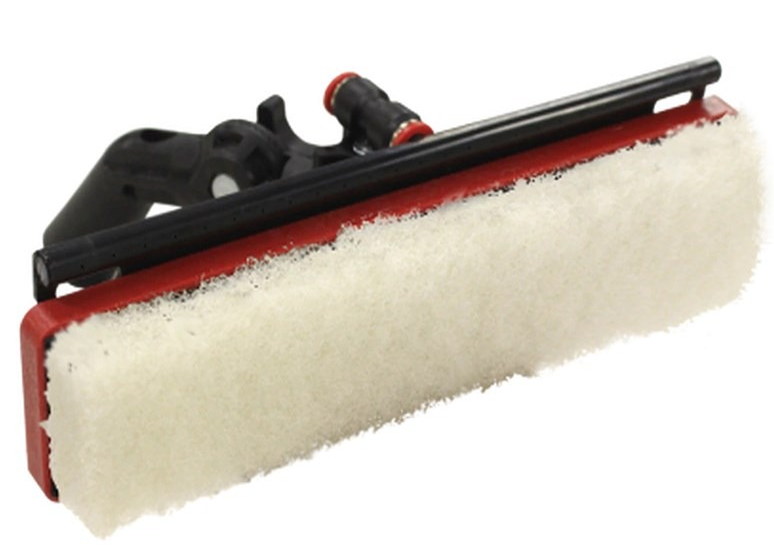Choosing a Water Fed Pole Brush
Water fed pole systems utilizes brushes to scrub the windows and get them clean. Brushes come in a variety of styles and materials, which makes choosing the right one kind of confusing. That's where this guide can help.
Brush Material
Most brushes are made from nylon or boar’s hair, or a combination of both. Let’s look at the differences:
Nylon Brush Bristles: Because nylon is a synthetic material, it can be designed to come in a variety of lengths and thicknesses. Nylon bristles are smooth (i.e., “monofilament”) which does not offer the same scrubbing power as boar’s hair. Nylon tends to last longer than boar’s hair. Most pole purchases -- no matter where you buy them from -- come with a nylon brush. These are more affordable and great for general maintenance cleaning.
Boars Hair Brushes: The unique thing about a boar's hair is that it is naturally flocked with split ends, meaning each bristle is actually made up of several tiny bristles. This provides extra scrubbing power that you do not get with nylon brushes. Boars hair naturally absorbs water, and the constant moisture aids with the scrubbing. It can also get really close to the glass, making it a great choice for first-time cleanings, as the windows will be dirtier. However, the bristles do not last as long. Also, boars hair absorbs a lot of dirt, which means you cannot leave boar's hair brushes against the glass when rinsing because that dirt is still in the brush and you cannot get as clean of a rinse. However, you can clean the dirt out of the brushes easily afterward with just by swishing it around in a bucket of water and a little soap, similar to your own hair.
As an added point, there are now also some nylon brushes that come in flocked styles to mimic boars hair while costing less.
Hybrid Brushes: Some brushes offer a combination of both nylon and boar’s hair, offering a happy medium and the best of both options. The nylon fibers are on the outside, while shorter boar's hair fibers are in middle.

Nylon Brushes
- Softer synthetic material
- Smooth bristles
- Less aggressive than Boar’s Hair
- Less expensive than Boar’s Hair
- Lighter than Boar’s Hair
- Lasts longer than Boar’s Hair
- Best for reaching higher windows because you can leave the brush on glass for rinsing
- Good for window maintenance that don’t require as much scrubbing
Bristle Trim
The length, or “trim” of the bristles is another thing to consider. These typically come in a couple of options.
Single Trim means the bristles have a straight trim, which are the same length throughout. This is particularly true of boar’s hair brushes because all the bristles move and work together when you apply pressure to the glass.
Double Trim brushes are made up of two different layers of bristle lengths, with the outside being longer and the middle being shorter. This can be found in brushes that contain nylon-only bristles, as well as those combo brushes that have nylon on the outside and boar’s hair in the middle. When you apply pressure with the brush, the outside bristles spread out along the glass, helping provide better control, while the inner bristles scrub.
Brush Size
Brushes typically start at 12 inches and go up from there. Smaller brushes, like the 12-inch, are used mostly for residential, although some homes have large windows and longer brushes are better. Longer brushes, such as an 18-inch brush, are good for larger surfaces because you can clean more area faster. However, the larger the brush, the more the pressure you apply and the water you use is spread out, so you have less concentrated scrubbing power.
Smaller brushes (i.e., the 12 inch) don’t cover as much area, but they do scrub harder. As a general rule, if you have a large window, a larger brush is a better option. If you have a smaller window or a window that has not been cleaned in awhile, your 12-inch is probably the best bet to get it good and clean.
The Alpha Scrubber
A New Alternative for stronger scrubbing power
The brush also includes Tucker's proprietary swiveling gooseneck, allowing the bush to slide across the glass without having to remove it from the glass.
The scrubbing brush comes with 10 replacement pads.
Brush Jets
WFP brushes come with either pencil or fan jets, although some designs offer both.
Pencil jets are straight streams that spray directly onto the glass, and are particularly useful for scrubbing because it gets the window wetter and helps dislodge contaminates.
Fan jets disperse the spray, giving the water farther reach. Fan jets let you clean farther, faster, and are great for windows that don’t need a lot of scrubbing. It the windows are pretty clean to begin with, fan jets are a better option.
Rinse Bars are a popular addition that can be installed along the top (or bottom) of your water fed brush. These have small holes placed uniformly across the length of the bar, and allow for multiple pencil jets to spray purified water simultaneously while rinsing. Locating them along the top of your brush ensures that water is the last thing to touch the glass, not your dirty brush.
Number of Jets
Smaller brushes (e.g., 12 inch) typically comes with two jets, while larger (e.g., 18 inch) come with four. Using four jets allows for more water flow, which means faster rinsing.
How Glass Coatings Affect Jet Choice
Hydrophillic Glass
Hydrophillic glass coatings are designed to "self clean" by attracting water to the coating. When water runs down the coating, it spreads out and is pushed off the glass in sheets. The problem is that the coatings not only attract water, they attract soap particles, which attract more dirt. That's why using a water fed pole is a great option for hydrophillic glass since you are using pure water without soap.
With hydrophillic glass, pencil jets are best because they provide a concentrated spray for cleaning that expands due to the spreading-out of the droplets.
Hydrophobic Glass
Hydrophobic glass has been treated with a coating that makes the glass repel water. It forces water to break down into tiny droplets or beads, that roll down the glass. They do not create a sheeting action like hydrophillic, which is what you want. You can, however, artificially create a sheeting action by using fan jets, which help spread those droplets out.
Caring for Your Brushes
1.
Set Them Down Carefully
If you set your brush down somewhere, make sure that you turn the bristles away from anything that can cause them to collect dust, like the ground or a wall. If the bristles collect dust, it will spread it onto the glass when you clean.
2.
Soak Them Regularly
If you set your brush down somewhere besides in pure water, make sur that you turn the bristles away from anything that can cause it to collect dust, like the ground or a wall. If it collects dust, it will spread it onto the glass when you clean.
3.
Store Them Properly
When not soaking, lay your brushes flat in a container with nothing pressing on the bristles.




